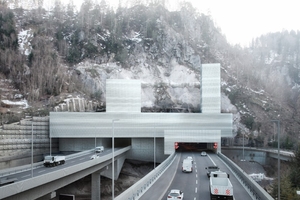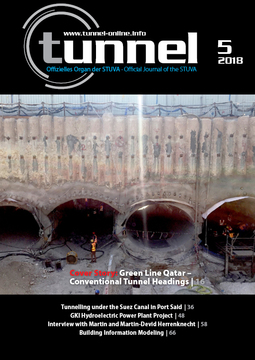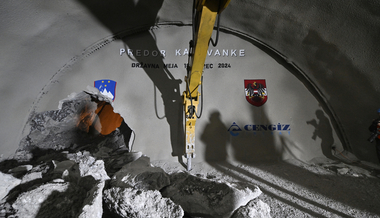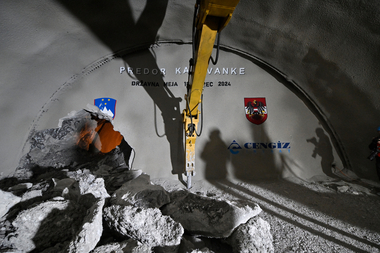Karawanken Tunnel:
ASFINAG starts
Construction of the second Tube
On September 18, 2018, ASFINAG (Austrian Motorway Authority) heralded in the complete further development of the Karawanken Tunnel with the ground-breaking ceremony on the A 11 Karawanken motorway. Thanks to this new structure cofinanced by the EU, the two-way section on the important north-south link between Austria and Slovenia will soon be a thing of the past. This will provide more traffic safety quite apart from bringing a significant relief for the route, which is particularly busy in summer. Outside the holiday season, some 10 000
vehicles use the A 11 Karawanken motorway on a daily basis; in the summer months, however, the figure swells to more than 30 000 vehicles per day. Congestion is inevitable on account of the restricted capacity provided by a single tunnel tube.
During the course of the next five years therefore, the second, almost 8 km long tube will be excavated from both sides. The breakthrough is scheduled for 2022, which will be followed by the inner lining as well as installation of ultra-modern safety equipment. After refurbishing the existing tube opened back in 1991 – which will probably be carried out from spring 2024 till early 2026 – the route will have been completed.
The ASFINAG started its preparatory work at the north portal in 2015. Thus, by autumn 2017, the access section leading to the tunnel portal including a 350 m long bridge was in place. Tenders were invited for tunnelling in conjunction with the Slovenian motorway operator DARS at the end of 2017. After thorough scrutiny of the offers, the Austrian joint venture of Swietelsky Tunnelbau GmbH & Co. KG and Swietelsky Baugesellschaft m.b.H. was commissioned to undertake the project in August 2018.
4.4. km Drill and Blast through the Mountain
The JV Swietelsky Tunnelbau and Bau GmbH is already forging ahead with building the new tube. By late 2021, the 4.4 km on the Austrian side will have been tunnelled by blasting and excavators. 1.44 million t of rock will accumulate in the process. The additional escapeways (cross-passages) set 350 m apart will be driven parallel to the tunnel excavation. In mid-2022, the tunnel breakthrough from the Slovenian side is expected.
Timetable until the
Tunnel is opened for Traffic
Subsequently, the tunnel inner lining will be tackled by setting up the inner lining and carriageway. As from 2022, furnishing with all safety installations will commence. The new tube will probably be opened for traffic in February 2024. Immediately afterwards, the existing tube will be refurbished. The ASFINAG has already carried out extensive improvements in it since 2006. As a result, redevelopment work will be minimal. However, on the Slovenian side, more far-reaching and thus time-consuming measures must be undertaken. As things stand, the complete project will be ready to fully accommodate traffic at the beginning of 2026.
Delay on the Slovenian Side
“We’re delighted you’ve already begun work on the Austrian side”, commented Tomaz Vidic, managing board director of the Slovenian project partner DARS. “We were in tandem until the tender was published. Then unfortunately three bidders on the Slovenian side objected to the outcome so that the path till the decision has been legally approved can be a long one. We will do everything in our power to ensure that work can start on the Slovenian side as soon as possible”.
Premium Safety Technology
As from 2026, the new tunnel will be equipped with the very latest technology, especially with respect to safety installations. Furthermore, the tunnel will be provided with premium safety equipment, which in the event of a disturbance (say caused by an accident in one of the tubes) enables the traffic pattern to be switched to temporary two-way within minutes. In the pre-portal area, reservation strip distribution systems (MÜLS) are set up. These are concrete guide walls that can be automatically swivelled so that traffic can be guided to the “other side”. As a result, each tunnel tube must be fitted to accommodate possible bi-directional traffic – from the ventilation to the traffic signs.
Tunnel planned with
3D Model
For the new project, ASFINAG selected digitalisation. In the case of BIM, Building Information Modeling, all relevant structural data are compiled digitally in a 3D-model. In this way, it is evident at any time just who was responsible e.g. for installing lights or where cables were drawn and what the nature of the concrete is. Thus, BIM provides utmost transparency for planning and construction as well as enormous advantages for servicing when carrying out maintenance operations or refurbishing after a few years.




